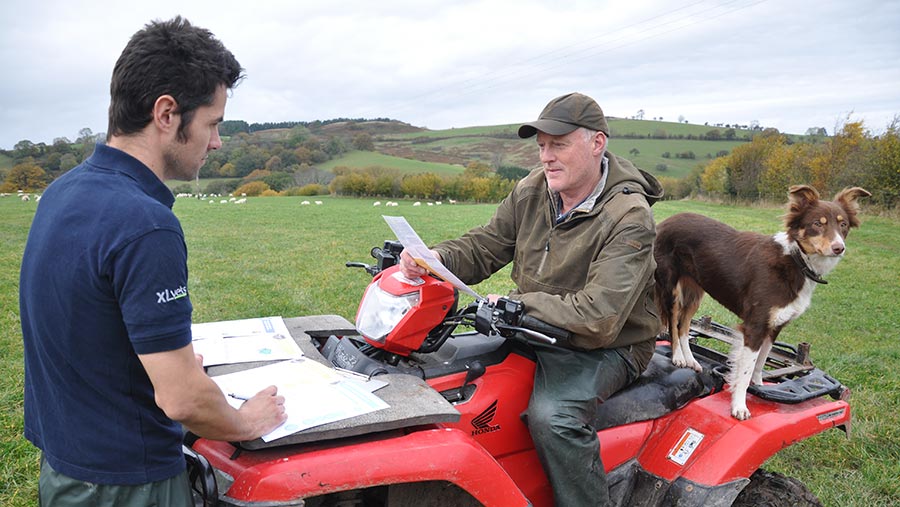How to get the most from a Defra sheep health and welfare review
 © Agribusiness
© Agribusiness Preparing flock performance figures for the new state-funded vet consultation will help sheep farmers get the most out of their Animal Health and Welfare Pathway visit.
Animal health experts say farmers should consider performance problems, successes and ultimate goals before vets arrive on farm this year, so that they get the most value from the visit.
Close to £500 is available for farmers to pay a chosen vet for an annual flock health review.
See also: A guide to working out drench resistance in your flock
The support comes from Defra’s Agricultural Transition Plan (2021-24) to help farms:
- Transition to higher-welfare practices and systems to be more sustainable
- Improve biosecurity to help manage endemic disease
- Tackle antimicrobial resistance
- Cut greenhouse gas emissions and improve productivity in line with the 2050 net-zero goal and the 25-year environment plan.
Vets say the money available each year will comfortably cover a flock health plan, with money left over for other preventative measures such as post-mortem work, faecal egg counting, lambing shed consultancy or ram fertility checks.
Specialist sheep vets can be located online on the Sheep Veterinary Society website.
What is the annual health and welfare review?
- Defra will fund a yearly visit from a vet chosen by the farm
- This will be available from spring 2022 and run for three years
- £436 is available a year for farms with more than 20 sheep
Vets will be used to:
- Discuss health, welfare and biosecurity
- Use of medicines, antibiotics, vaccinations and so on
- Provide diagnostic testing (for example, anthelmintic resistance)
- Produce a written plan and report to help monitor flock health and performance.
How to get prepared
Kat Baxter-Smith, livestock veterinary adviser at MSD, said many farms will already have performance figures to hand.
But some businesses may have to do calculations to quantify performance and see what positive effect vet intervention has on output and profit.
To help vets investigate flocks and farming systems, Dr Baxter-Smith urged farms to collate and analyse the following data (see table).
Data that drive sheep profit |
Data businesses may already have |
|
|
She asked farms to consider what their commercial, breeding, pedigree and flock size aspirations were. This might include scanning, rearing rates and mortality rates in need of improvements.
MSD has produced a new flock planning tool – the Flock Health Checklist – which Dr Baxter-Smith said could be used to assess performance at crucial times in the sheep farming calendar (see box).
Flock health checklist
A free bundle of information sheets and checklists is available to help farms work with vets to highlight areas of improvement.
The checklist focuses on five key areas:
- Breeding period and late pregnancy
- Late pregnancy and lambing
- Growing, weaning and sales
- Disease and biosecurity
- Monitoring flock performance.
10 questions on the three crucial time periods (1-3) and management processes (4-5) can be worked through and areas needing attention pinpointed.
“Similar types of checklists have been available to dairy youngstock rearing units and beef suckler herds for a couple of years now, with several vets reporting that these tools have proved integral to their productivity improvement work with farmer clients,” she said.
“Use of this checklist-based approach is also helping better implementation of preventative health practices such as vaccination. We hope this latest tool will help the GB sheep industry in the same way.”
Sheep vet John Hemingway of Shropshire Farm Vets added that the checklist helped farmers and vets make management changes.
“Good vetting is not about curing sick animals, it’s about making changes to improve flock performance,” he said.
“I wish I’d had this planning tool 10 years ago, as it consolidates relevant information. You can’t review the whole sheep farm in one session, but this helps focus in on certain aspects.”
Prevention beats cure
Mr Hemingway said he had seen first hand how prevention is better than cure in flock health.
One flock had expanded to 450 ewes and lost 8% of lambs to twin lamb disease. On inspection, vets found that although feed analysis suggested diets were balanced appropriately, feed access was insufficient.
“For the cost of 60 minutes of vet time the farm could have avoided this by having a vet visit and ensure feed space and loafing area were sufficient,” he said.
“[In the end] the farm needed to pay for 60 minutes of vet time anyway, and also had to suffer catastrophic production losses.”
